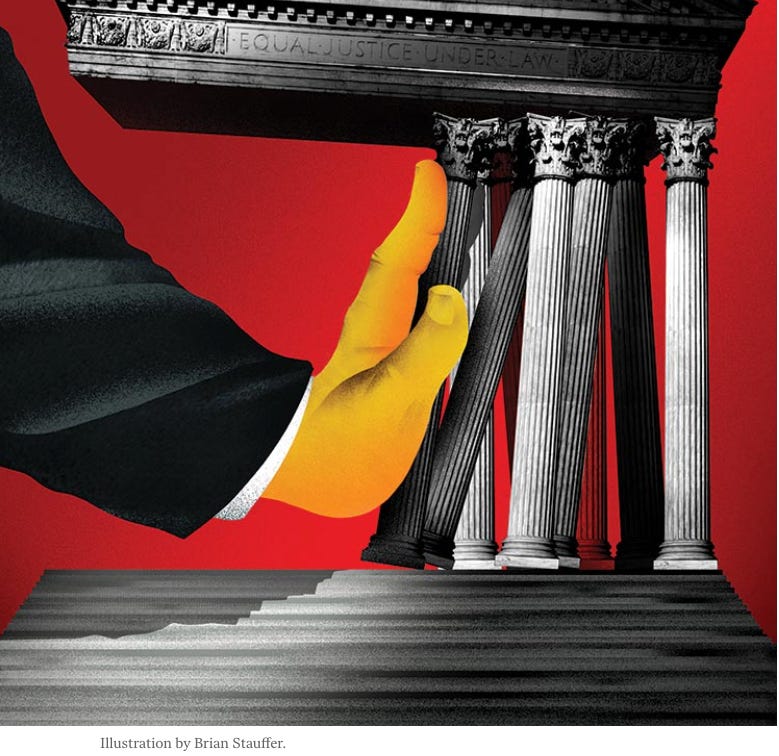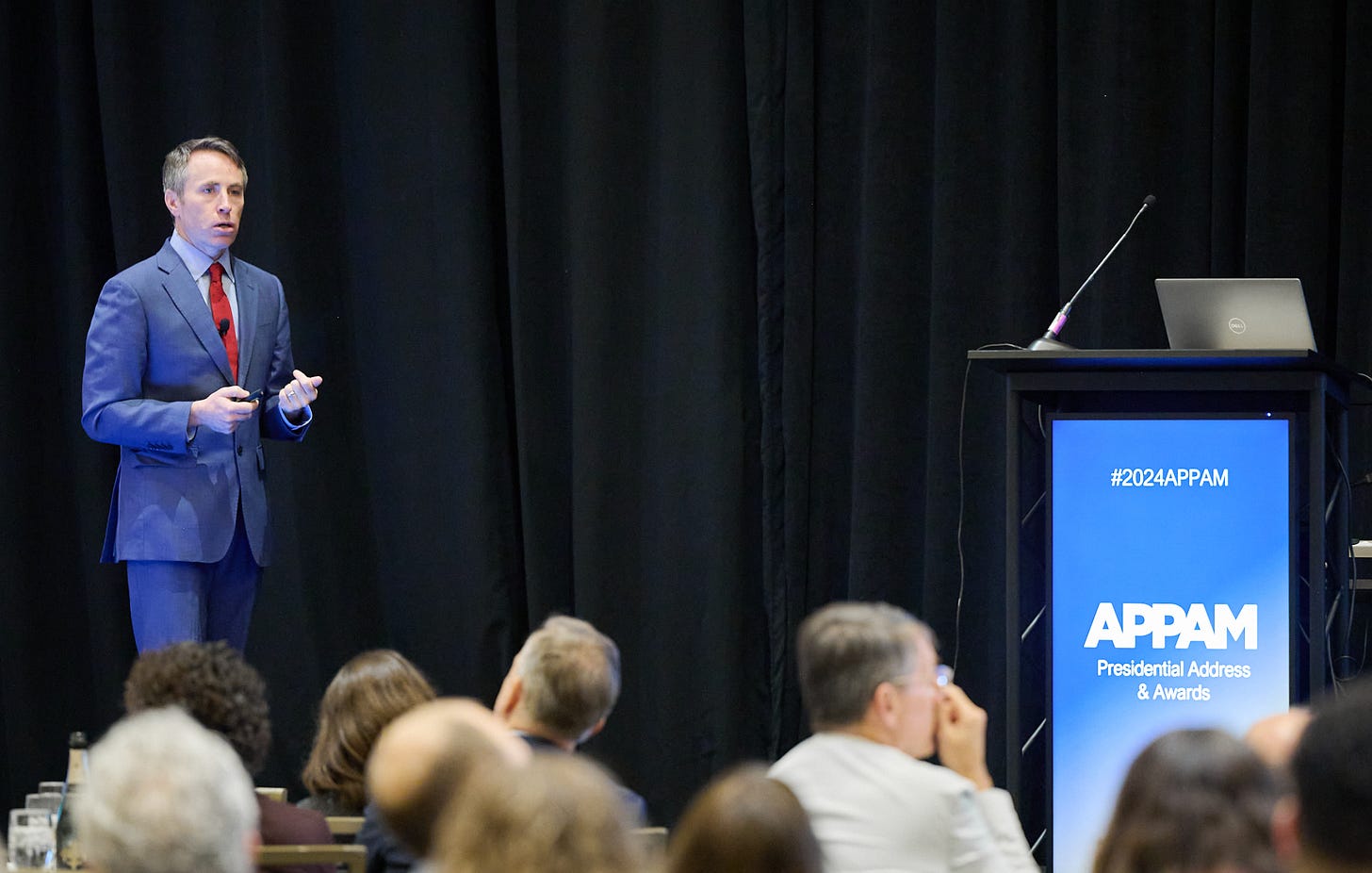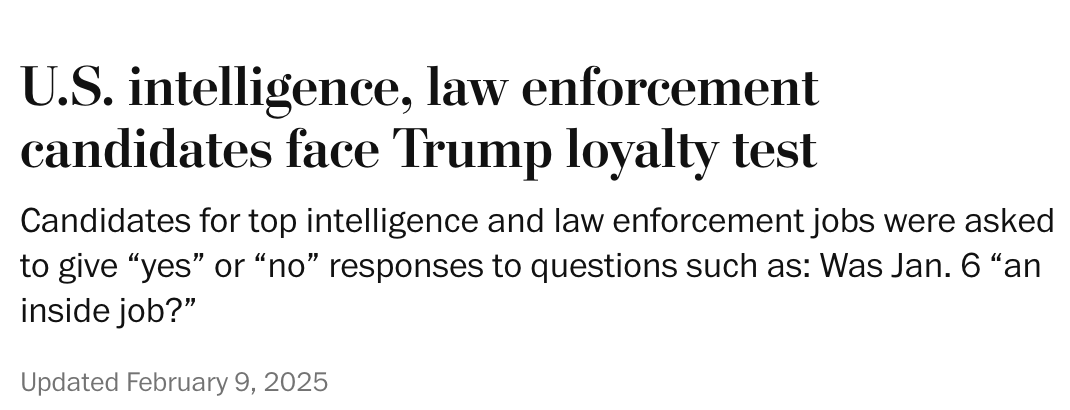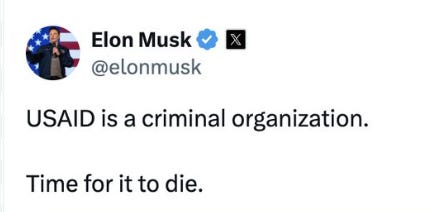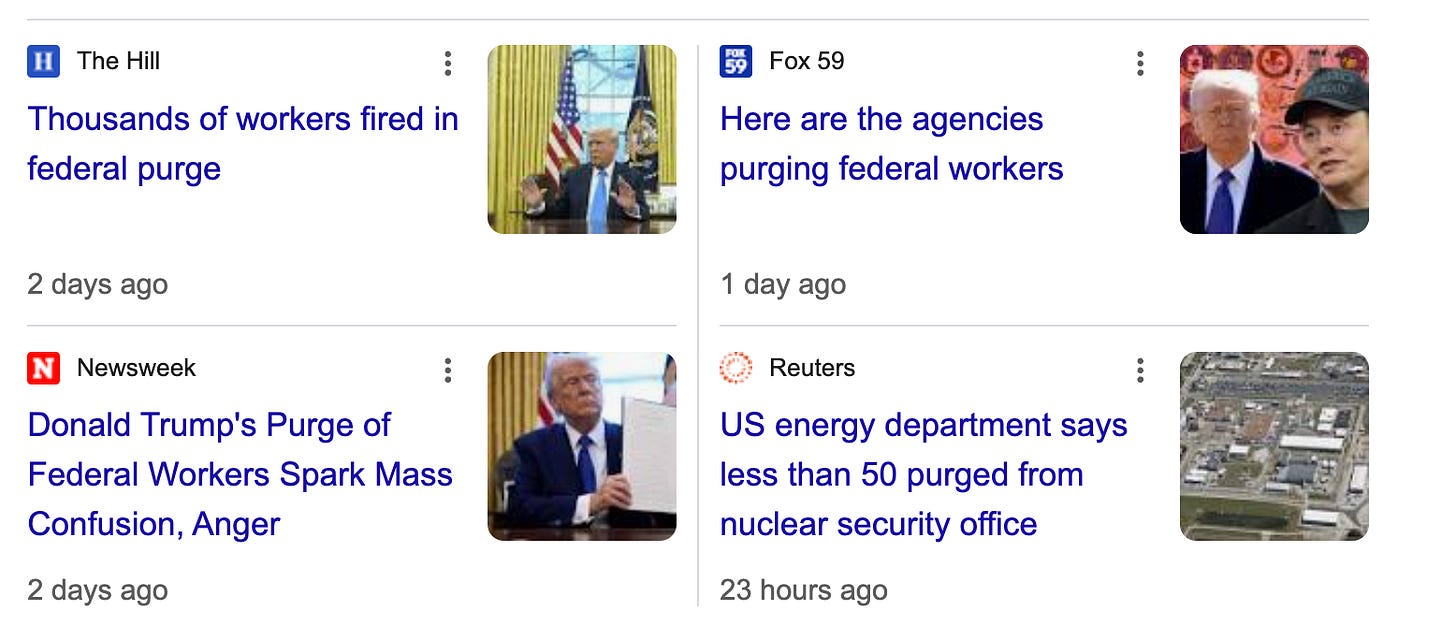Right now, so many things are happening so quickly that it is hard to keep up. This is part of a deliberate strategy to “flood the zone” with so many changes that it is impossible to make sense of them all. I’ve been trying to step back and identify bigger patterns that help us to frame and understand these events, rather than just respond to them. Just after the election, I gave the presidential address to the Association for Public Policy Analysis and Management. I am providing lightly edited excerpts below. If you want the extended version with lots more citations, it has been published in the Journal of Policy Analysis and Management.
For a considerable period, from about the 1970s until relatively recently, politicization of the U.S. federal government describes a President using two basic strategies: centralizing policy expertise within the White House, and using political appointees to strategically manage agencies, especially agencies that do not ideologically align with the President. Both political parties applied such strategies, to varying degrees, within a certain equilibrium. The President was assumed to value a balance between loyalty to his policies, and administrative competence in delivering those policies. The civil service system was assumed to be a stable source of institutional capacity, with basic workforce protections for employees. Within that equilibrium, the number of political appointees has gradually increased, from about 3,000 in 1990 to about 4,000 today, even as the number of career federal employees they supervised remained relatively stable since the 1960s.
That equilibrium no longer exists. Direct forms of political control are more extreme, and the types of politicization are more varied than the centralization of policymaking power and strategic use of appointees. The core components of the new politicization are
1) The personalist presidency - centered on loyalty to Trump with a legal infrastructure built to serve and protect him
2) Governing by fear via conspiratorial messaging towards the public sector and threatening individual public servants
3) Purging of career officials, expansion of appointee class by weakening of civil service systems, and dismantling civil service protections.
A Personalist Presidency
The emergence of Trump has compelled scholars focused on US domestic politics and policy to look to comparative research for useful explanatory concepts, such as populism and personalism. While populism centers on a grievance-driven us-vs.-them ideology, personalism centers on the idea of a political movement built around loyalty to an individual leader. Personalism is more likely to prevail in settings featuring weak political, democratic and governance institutions, and so the emergence of personalism in the Grand Old Party and the United States challenges prior assumptions. While loyalty to Trump may falter in his last years in office, he has been able to silence or drive from power dissenters within the Republican Party and seeks to do so within government.
If previous descriptions of executive power used terms like “the administrative presidency” or the “imperial presidency” Trump has created the conditions for a personalist presidency, reorienting processes and powers to reward the value of loyalty. Personalist systems are more likely to feature family members, or those who have passed extraordinary loyalty tests, such as joining in false claims the leader makes or defending damaging behavior, such as the denial of an election loss. Trump fumed about resistance from his own appointees in his first term, who often balked at actions they saw as illegal, impulsive, unvetted or otherwise inappropriate. His concerns about loyalty spiked after his first impeachment, after which he aggressively used the Presidential Personnel Office to more intensely screen appointees for loyalty. His former Chief of Staff, John Kelly said “The lesson he learned was to find sycophants.” Personalism is the enemy of rules-based or merit-based system for governing; logics of governing are tied to the leaders evolving preferences rather than consistent application consistent formal policies.
His second term Cabinet nominations were largely not the type of generic Republican that characterized his first term, often holding few credentials for the position beyond their loyalty to Trump. A willingness to stand with Trump during his lowest period, after the 2021 January 6th assault on Congress by his supporters, became a key criterion. Donald Trump Jr described the appointee screening process: “Loyalty has got to be number one,” emphasizing that the Presidential Personnel Office “will diligently go through and understand not just where were they in 2015 and 2016, but where were they on January 7th”. Candidates for appointments were screened with questions like whether they believed Trump’s false claim he won the 2020 election and how they evaluated the 2021 January 6th insurrection.
Trump’s governing style became more personalist over time, rather than more aligned with traditional governing norms. This involves not just how he manages appointees, but his own conflicts of interests. Personalist regimes encourage private actors to direct resources to the leader. As President, Trump has blurred his personal roles and presidential office, failing to create a firewall between his businesses, legal entanglements and his public office. The subsequent expansion of his business interests into social media and crypto holdings, combined with the permissive nature of the US campaign finance system, enables the appearance of quid-pro-quo arrangements. For the personalist leaders, this creates the need for a legal infrastructure that would enable such use of a public office for private benefit.
Trump latched onto legal theories that empower a personalist presidency. He has reframed the unitary executive theory of governing as meaning that “I have the right to do whatever I want as President.” While crude, Trump’s interpretation of Article II constitutional powers echoes how his previous Attorney General directed Department of Justice lawyers: “Constitutionally, it is wrong to conceive of the President as simply the highest officer within the Executive branch hierarchy. He alone is the Executive branch. As such, he is the sole repository of all executive powers conferred in the Constitution.” A series of Supreme court decisions, most notably the 2024 Trump v. United States decision on presidential immunity, have broadened Presidential protections from legal liability for his acts in office, while expanding his presidential authority over personnel. As these legal theories are codified into practice, they create a framework for unchecked personalism.
To maintain Trump’s personalist Presidency requires defanging standard modes of presidential accountability. In his first term, Trump fired Inspectors General at an unprecedented rate, removed the head of the FBI, and complained about Department of Justice investigations. A key lesson he drew from his first term was to build an even stronger legal infrastructure to further shield him from risk and increase his power. Trump and supporters eliminated the long-standing norm that the Department of Justice maintain a measure of independence from the President, enabling him to directly intervene in cases involving investigation of himself, or his political opponents.
More broadly, putting loyalists in key White House, Department of Justice and General Counsel positions across government, expands presidential power at the expense of precedent. For example, many of these public positions are filled to an unprecedented degree with Trump’s private lawyers, who have demonstrated their loyalty through attorney-client relationships. These include the top two positions at the Department of Justice.

General Counsels operate as the internal referee within government agencies. As they become more willing to enable novel and radical action, they cease to operate as an internal control, putting greater weight on less frequent, expensive and lengthy lawsuits as a check against abuses of legal powers. Russ Vought, Trump’s Office of Management and Budget (OMB) Director described a vision of an ideal General Counsel as “creative and fearless in his or her ability to challenge legal precedents that serve to protect the status quo.” In their time in leadership of OMB, Vought and his General Counsel Mark Paoletta blessed Trump’s withholding of aid to Ukraine that led to Trump’s impeachment, over career staff objections, and have advocated for novel legal theories such as allowing the President to impound funds appropriated by Congress.
Under personalism, competence matters much less than loyalty in how the leader assesses appointees. Evidence matters less than the leader’s beliefs. As a result, agencies are less likely to be run by leaders with obvious attributes of competence, such as relevant experience, or knowledge of the policy field. The ideological placement of the appointee, or the agency, will matter less than the willingness of the appointee to embed values of loyalty to the leader. In the case of a leader with authoritarian tendencies, and legal troubles, they will disproportionately focus attention not on improving the quality of service-providing agencies, but on securing control of the national security, military and legal components of the government.
Governing by Fear
A skepticism about government, and a willingness of political leaders to run against Washington DC is a trademark of American politics. An embrace of conspiracy theories – what Hofstadter labeled “the paranoid style” is also nothing new. But a central effect of the rise of Trump is the mainstreaming of conspiratorial messaging. The target of this conspiratorial messaging is often public officials. Populism depends upon an us-vs.-them dynamic where a shadowy elite is undermining the true people. Trump incorporates anti-statist rhetoric to portray state actors as the “them” (alongside other groups, such as immigrants). His rise to power in Republican circles rested upon his embrace of birtherism, the false claim that President Obama was born outside the United States, and therefore illegitimate. He has embraced elements of Q-Anon, which center on the idea that public officials are involved in a satanic sex-trafficking of children, and the Big Lie, which falsely claims he won the 2020 election. Trump’s popularizing of the “deep state” trope emphasized the idea of public institutions as inherently corrupt and unaccountable, involved in conspiracies to hurt the public.
Trump is therefore different in his embrace of rhetorical attacks upon the public sector than his predecessors in White House roles. He is also different in the use of threats and intimidation against public officials, including nonpartisan public officials that he disagrees with. This has included Generals who served him, FBI officials, judges, lawyers or court officials involved in his legal cases, whistleblowers and witnesses who testified against him, local election or public health officials. He has normalized both broad attacks upon the public sector, and upon specific public employees, as within the scope of presidential power.
Most obviously, President Trump created a permission structure for such attacks, including by attacking career officials in his own administration. Social media allowed those attacks an unfiltered reach to the mass public, some of whom could further this harassment with more overt threats. What might have been a one-day newspaper article in a previous generation now has a permanent digital footprint. Supporters may start their own harassment campaigns, consistent with the general themes of their political movement. For Trump supporters, this means that a whole swathe of public officials – such as judges, those working in education, public health, regulation of information, or election administration – were deeply corrupt and subject to threats.
Threats and intimidation might be seen simply a side effect of robust political discourse, where leaders cannot be held accountable for the most extreme voices in their movement. This underestimates the degree to which they serve as a tool of control, intended to induce fear, and by doing so reduce pushback. The need for such control becomes necessary when public officials are asked to operate under conditions of extreme and unwelcome change, such as the conversion to a personalist Presidency, legally questionable actions, or working with agency leaders who oppose the mission of the agency.
OMB Director Russ Vought said: “We want the bureaucrats to be traumatically affected. When they wake up in the morning, we want them to not want to go to work because they are increasingly viewed as the villains. We want their funding to be shut down so that the EPA can't do all of the rules against our energy industry because they have no bandwidth financially to do so. We want to put them in trauma”.
Trump put Elon Musk in charge of downsizing government, even though Musk had a track record of launching social media attacks of individual regulators of his businesses. Musk also publicly identified individual federal employees whose positions he wanted to cut. One victim of these attacks was forced to move after a torrent of death threats. She described civil servants quitting their jobs before Trump took office, suggesting that Musk wanted them “to be intimidated and just go ahead and quit so he didn’t have to fire them. So his plan, to some extent, is working.” Federal employees are increasingly afraid to go on the record about the attacks they face and the damage being done to government.
Purging of Career Officials, Expansion of Appointee Class
Threats and intimidation represent a use of informal political power, but can be combined with formal power. A personalist legal infrastructure can be turned on civil servants, by, for example, launching investigations into employees, denying security clearances, or relocating or reassigning them. The most potent personnel tool in the new political model is the Schedule F Executive Order. Signed by Trump at the end of his first term, Schedule F offers a legally untested claim that the President can convert civil servants into political appointees. Without career employment protections, such employees serve at the pleasure of the President and can be dismissed for political reasons.
The Schedule F executive order specifies that the Presidential authority to reclassify employees from civil service to political appointee status extends to any employees with a policy advisory role, a vague and undefined category that could be extended to tens or even hundreds of thousands of civil servants. Schedule F represents the first time that civil servants would be stripped of job protections and compelled to become political appointees. It represents the most significant change to the dynamics of the federal civil service system since its creation in 1883.
The ability of the President to fire career officials increases the chances that mechanisms of personnel politicization will be substantially activated – the departure of more capable officials, to be replaced by less capable zealots, lower investment in expertise, and a short-term focus that values the interests of political allies over public goals. This applies not just to rank and file civil servants. Trump has ignored job protections for Inspectors General, and appointees to independent bodies such as the Merit Systems Protection Board.
The absence of job protections also makes it more difficult for public employees to oppose illegal behavior or other abuses of public offices. For example, career officials in a variety of ways – through warnings to the White House, whistleblower testimony, and providing evidence to Congress – sought to prevent and then cast light on illegal actions that led to Trump’s first impeachment. In the aftermath of the impeachment, Trump publicly attacked them punished them to the greatest degree allowed by law. Many left the federal government. With Schedule F, it is less likely they would raise concerns about wrongdoing and more likely that a President could fire them if they did so.
Schedule F offers the most straightforward tool to alter the traditional equilibrium between career officials and political appointees. It does so in two ways. First, there will simply be many more appointees than in recent history. The vast majority of these appointees, at least initially, will not look like traditional appointees, since they will have more experience and a career background. Instead, they blur the line between career officials and appointees by converting former career official into appointee status. These are a form of appointees not selected because of intrinsic loyalty to the leader, but to impose loyalty considerations upon those who were traditionally outside of the political class of public servants.
Second, the potential for significant purges of public employees will increase. In the short run, the Trump administration is removing tens of thousands of officials. In the long-run, the negative effects of electoral transitions on state capacity will increase. Currently the 4,000 or so appointees selected by the President are expected to exit at the end of each administration, meaning that public organizations experience significant instability with such mass transitions. We do not know how many of the tens of thousands of Schedule F appointees will likewise be pushed to leave by a new President if they are viewed as loyal to the prior administration.
These frames will not completely capture what will occur in the years ahead. For example, I am still not sure how to consider DOGE, since we’ve never really seen anything like this before. But I do think they will help us to better see how Trump’s actions fall into a bigger picture, and I expect to come back to them in the years ahead.



